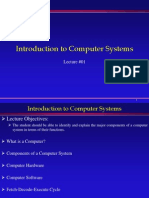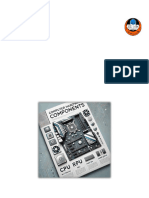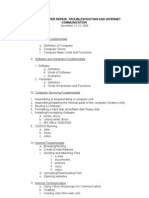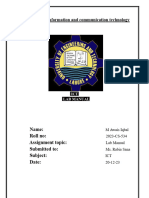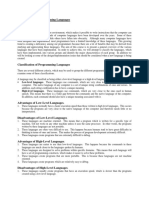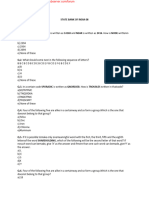Notes On Hardware and Software
Notes On Hardware and Software
Uploaded by
api-281051002Copyright:
Available Formats
Notes On Hardware and Software
Notes On Hardware and Software
Uploaded by
api-281051002Original Title
Copyright
Available Formats
Share this document
Did you find this document useful?
Is this content inappropriate?
Copyright:
Available Formats
Notes On Hardware and Software
Notes On Hardware and Software
Uploaded by
api-281051002Copyright:
Available Formats
Title: Hardware and Software
Page 1 of 3
QUESTIONS/SUMMARIES
What is software?
What are the two types of
software?
What are the two types of
system software?
What are the four categories of
hardware?
What is the function of each of
these four categories?
What are the different types of
storage?
What are the features of the
different types?
What is the difference between
volatile and non-volatile storage
and what are some examples of
each?
Name: Emily Edwards______
Class: ICT EDUC5464______
Date: 05/05/15____________
NOTES:
Software: program or application
Allows you to do many things such as word documents,
PowerPoints, etc.
Application
o
User choice
o
Non-essential
System software
o
Operating system: essential runs all systems, e.g.
Windows
Provide user interface
Manage process
Manage resources
Manage memory
Provide security
o
Utility system: essential but additional options helps to
manage the computer e.g. Antivirus, defrag
Performs very specific tasks
Related to managing system resources
Hardware: Four categories of hardware - IPOS
Input = any machine that feeds data into computer. Raw and
unreadable
o
E.g. keyboard, mouse, microphone
Processing = Getting raw data and need to do something with it so it
means something
o
Any device that handles this intermediate stage
o
Responsible for controlling the storage and retrieval of
information
o
E.g. Graphics processing unit, sound card, network
card
o
Can go to either output or storage
o
Changes raw data to information e.g. keyboard typing
to a sentence.
- Output = Information that is meaningful
o Any peripheral (outside) that receives data from a
computer
o E.g. printer, speaker
- Storage = any hardware capable of holding information on a
computer
o
Volatile: Once the computer is turned off the data is gone
o Non-volatile: Saved permanently
o Primary (Internal)
RAM, cache, ROM
Cache: Holds memory for a short period of time
(volatile)
Lower access time, faster performance, more
costly than secondary storage
ROM: boots up computer
o Secondary (internal or external)
Permanently stores data
E.g. USB, hard drives (internal/external), CDRW, cloud storage
Computer
Power supply: components need power
RAM: cleared when you turn off computer
Title: Hardware and Software
Page 2 of 3
QUESTIONS/SUMMARIES
What are the six components of
a computer and what do they
do?
Name: Emily Edwards______
Class: ICT EDUC5464______
Date: 05/05/15____________
NOTES:
- Heat sink: draws heat away from CPU
- CPU: brain of the computer
- Motherboard: circuit board. Contains CPU, RAM
- Expansion slots: better sound cards, wireless connection card
CPU
What is the CPU, what are its
components and what does it
do?
Brain of computer, carries out commands and controls flow of
information between parts of computer
Silicon chip, control unit, arithmetic and logic unit (ALU), main
memory and bus.
Bus is a system of wires that information travels along
Responsibility of ALU: manages all the arithmetic equations of the
system
- Responsibility of control unit: managing system resources
Motherboard
-
Holds and connects all of the computers components, allowing them
to communicate with each other, provides power to all the
components
Five basic components: RAM, CPU, input output ports, expansion
slots, storage device connection
Short term, holds currently used data, allows computer to run
What are expansion card slots?
Electronic circuit boards that adds more functionality to a desktop
computer
What are some examples of
expansion card slots?
Allow the computer perform additional functions
Sound card: send economical input and output of audio signals
What are the five components of
a motherboard?
What does a motherboard do?
What is RAM?
RAM
Volatile: specialises in only want you are directly using
RAM clock speed: Speeds at which it reads and writes data
Measured in GB and how quick its accessed, read or written in MHz
Affects system running speed if you dont have enough RAM it will
have to revert to the hard drive which is slower. Computer crashing
can be caused by the hard drive trying to catch up to the RAM
Expansion card slots
PCI: Peripheral component interconnects
Video card: allows the computer to send graphical information to a
video display
Network card: slows access to the internet wirelessly
Bluetooth card: allows the computer to connect and send information
using bluetooth
Summary/Reflection:
Hardware and software are both essential for computers to function properly. Software can either be
essential, such as your operating system or defrag, or non-essential such as MS Word. Hardware has
four categories, input, processing, output and storage. They can be remembered with the acronym
IPOS. A computer has six components, a power supply, RAM, heat sink, CPU, motherboard and
Title: Hardware and Software
Page 3 of 3
Name: Emily Edwards______
Class: ICT EDUC5464______
Date: 05/05/15____________
expansion slots. The CPU is the brain of the computer, he motherboard allows communication
between the components, RAM holds short term data that is currently being used and expansion card
slots add more functionality to a desktop computer.
You might also like
- EDU430 - ICT in Education (QUIZ NO 1) MCQS 58Document2 pagesEDU430 - ICT in Education (QUIZ NO 1) MCQS 58Ali AkbarNo ratings yet
- Work Effectively in An Information Technology EnvironmentDocument27 pagesWork Effectively in An Information Technology Environmentapi-247871582No ratings yet
- Fundamentals of Computers and OSDocument10 pagesFundamentals of Computers and OSTuhin Saha100% (2)
- A+ Guide To Hardware, 4eDocument62 pagesA+ Guide To Hardware, 4eepriyaa100% (4)
- Lecture 01Document69 pagesLecture 01jihad0004.sepNo ratings yet
- IBPS PO Computer DigestDocument28 pagesIBPS PO Computer DigestAravind BhomboreNo ratings yet
- Computer Fundamentals and HTMLDocument9 pagesComputer Fundamentals and HTMLGautham SajuNo ratings yet
- 1) Computer Concepts NotesDocument6 pages1) Computer Concepts NotesVenus Leilani Villanueva-Granado100% (2)
- Intoduction It Hardware-1Document11 pagesIntoduction It Hardware-1Nishitha PriyankaNo ratings yet
- Intoduction It Hardware-1Document11 pagesIntoduction It Hardware-1Nishitha PriyankaNo ratings yet
- AssignmentDocument6 pagesAssignmentapi-257167729No ratings yet
- Development of Computer Organizatio1Document8 pagesDevelopment of Computer Organizatio1Salsabila IrbahNo ratings yet
- Trabajo ComputadoresDocument7 pagesTrabajo ComputadoresCristian Aguirre RamirezNo ratings yet
- Smcsxi PDFDocument92 pagesSmcsxi PDFsrenathNo ratings yet
- L01 IntroductionToComputerSystemsDocument17 pagesL01 IntroductionToComputerSystemsDyan AngelicaNo ratings yet
- Introduction to ComputerDocument57 pagesIntroduction to ComputerIshi Montalbo100% (1)
- Fundamentals of Hardware and Software SummaryDocument64 pagesFundamentals of Hardware and Software SummarymikahstroudeNo ratings yet
- July 19Document19 pagesJuly 19Md. Mokbul HossainNo ratings yet
- Exercise Meeting 2: Following Question 1 - 3Document4 pagesExercise Meeting 2: Following Question 1 - 3Rafael BilliNo ratings yet
- Hardware chapte1Document55 pagesHardware chapte1EvaNo ratings yet
- Computer Has Four Main Parts. (1) Hardware (2) Software (3) Data (4) UserDocument7 pagesComputer Has Four Main Parts. (1) Hardware (2) Software (3) Data (4) UserRaj Kumar OadNo ratings yet
- Unit 8 - Information and Communication TechnologyDocument42 pagesUnit 8 - Information and Communication TechnologyAbhishek Dali100% (2)
- Lab Report 565Document18 pagesLab Report 565itzabdullah456No ratings yet
- C Digital Notes All 5 UnitsDocument193 pagesC Digital Notes All 5 Unitsfahad aliNo ratings yet
- Index: All About The Desktop ComputerDocument11 pagesIndex: All About The Desktop ComputermimirshNo ratings yet
- File 64477ffea2a9cDocument121 pagesFile 64477ffea2a9cAparna SamantarayNo ratings yet
- Class-11 CH-1 Computer SystemDocument15 pagesClass-11 CH-1 Computer SystemNEELMAY THAKURNo ratings yet
- Lesson 1 - Hardware ConceptDocument28 pagesLesson 1 - Hardware Conceptventinillakian149No ratings yet
- DOC-20240424-WA00042nd Chapter ComputerDocument16 pagesDOC-20240424-WA00042nd Chapter Computeranniedar752No ratings yet
- C Program NoteDocument77 pagesC Program NoteMityaprangya DasNo ratings yet
- Computer With StudiesDocument13 pagesComputer With Studiesemmakalenga754No ratings yet
- Computer Awareness NotesDocument10 pagesComputer Awareness NotesArihantSinghNo ratings yet
- Concepts of Information TechnologyDocument110 pagesConcepts of Information TechnologyamahaminerNo ratings yet
- Computer Hardware & It'S Component: Khalid KhanDocument26 pagesComputer Hardware & It'S Component: Khalid KhanmeghaNo ratings yet
- Reading - Material - On ITDocument37 pagesReading - Material - On ITKISHORETNo ratings yet
- Computer HardwareDocument3 pagesComputer HardwareOmkaar SampigeadiNo ratings yet
- Bcs-011 Important ConceptsDocument92 pagesBcs-011 Important Conceptsgamerslang1No ratings yet
- Unit - 1: 1.1 Introduction To ProgrammingDocument79 pagesUnit - 1: 1.1 Introduction To ProgrammingraviNo ratings yet
- Eswi Unit-1Document44 pagesEswi Unit-1bodduraghavendra08No ratings yet
- File 64477ffea2a9cDocument111 pagesFile 64477ffea2a9cAparna SamantarayNo ratings yet
- C Program NoteDocument77 pagesC Program NoteDibyansheeNo ratings yet
- Ict-Notes-Final-Copy-Introduction-To-Ict ModifiedDocument41 pagesIct-Notes-Final-Copy-Introduction-To-Ict ModifiedKawsu JarjuNo ratings yet
- Unit 1 - Fundamentals of ComputingDocument170 pagesUnit 1 - Fundamentals of ComputingPreetha VNo ratings yet
- PPS Unit-1Document109 pagesPPS Unit-1Sachin VermaNo ratings yet
- Unit-1 PPSDocument80 pagesUnit-1 PPSHarini KolliNo ratings yet
- Class 11-assignment-1-ITDocument3 pagesClass 11-assignment-1-ITTridip Pramanick 10-D-42No ratings yet
- CPT105 Final Exam Revision Term1 2013 With AnswersDocument6 pagesCPT105 Final Exam Revision Term1 2013 With Answersmnx4everNo ratings yet
- Computer Science Ncert HelperDocument17 pagesComputer Science Ncert HelpersrisaideekshithbhatdNo ratings yet
- BerlinDocument20 pagesBerlinbakrcyberNo ratings yet
- Training ProcedureDocument24 pagesTraining Procedureladsjovero6162100% (1)
- Introduction To ComputerDocument74 pagesIntroduction To ComputerJade TobiasNo ratings yet
- Icf 7 - Q1-W5-6 LasDocument14 pagesIcf 7 - Q1-W5-6 LasCathy De Andres GaspanNo ratings yet
- Application of Information and Communication Technology: Name: Roll No: Assignment Topic: Submitted To: Subject: DateDocument101 pagesApplication of Information and Communication Technology: Name: Roll No: Assignment Topic: Submitted To: Subject: Dateawaisiqbal132453No ratings yet
- Unit I: It E51 - Computer Hardware and Troubleshooting - Unit 1Document26 pagesUnit I: It E51 - Computer Hardware and Troubleshooting - Unit 1sankrajegowdaNo ratings yet
- Ict8 - PresentationDocument95 pagesIct8 - PresentationCashmir Mabaquiao JoquinoNo ratings yet
- Review For Next WeekDocument4 pagesReview For Next WeekBitoy101No ratings yet
- PPSunit 1notes21 22Document76 pagesPPSunit 1notes21 22pragnya18005No ratings yet
- Tle Notes-ComputerDocument11 pagesTle Notes-ComputerDENNIS AFABLENo ratings yet
- Computer Science: Learn about Algorithms, Cybersecurity, Databases, Operating Systems, and Web DesignFrom EverandComputer Science: Learn about Algorithms, Cybersecurity, Databases, Operating Systems, and Web DesignNo ratings yet
- JKSSB Syllabys Store Keeper 2019Document46 pagesJKSSB Syllabys Store Keeper 2019sajadNo ratings yet
- QUIZZERS-Auditing Theory-CISDocument5 pagesQUIZZERS-Auditing Theory-CISronsky1015No ratings yet
- (1958) Forrester PDFDocument31 pages(1958) Forrester PDFindiolandNo ratings yet
- Chapter 1 - The Importance of MISDocument47 pagesChapter 1 - The Importance of MISSelena ReidNo ratings yet
- Evolution of Traditional Media To New MediaDocument56 pagesEvolution of Traditional Media To New Mediaelizamaebeltran2910No ratings yet
- Alexandre 34801500 & Blanckaert 03781500 - 2020Document174 pagesAlexandre 34801500 & Blanckaert 03781500 - 2020qy5hwdwdbsNo ratings yet
- Computer Aided Process Planning (CAPP)Document22 pagesComputer Aided Process Planning (CAPP)fear to face100% (1)
- Beekman - Tomorrow's Technology and You 9eDocument89 pagesBeekman - Tomorrow's Technology and You 9eJimmy DrakeNo ratings yet
- Designing With A Robot-Interactive Methods For Brick Wall Design Using Computer VisionDocument8 pagesDesigning With A Robot-Interactive Methods For Brick Wall Design Using Computer VisionmadatdesignNo ratings yet
- Secadora ADC Industrial FichasDocument65 pagesSecadora ADC Industrial FichasGoliat1971No ratings yet
- Session 3 - Cybercrime Investigation (JSGUY)Document93 pagesSession 3 - Cybercrime Investigation (JSGUY)Bob PobreNo ratings yet
- TAS For Loading TruckDocument74 pagesTAS For Loading Truckjittshong8072No ratings yet
- Vacancy Public Announcement - Electrical and Instrumentation ManagerDocument2 pagesVacancy Public Announcement - Electrical and Instrumentation ManagerradikalgraphicsghNo ratings yet
- LESSON 2 - The Different Types of ComputersDocument30 pagesLESSON 2 - The Different Types of ComputersShierey Ann CalcenaNo ratings yet
- Knowledge Management and Specialized Information System: Gutierrez - Landicho - TerribleDocument50 pagesKnowledge Management and Specialized Information System: Gutierrez - Landicho - TerribletopherskiNo ratings yet
- Equipment Specialist Series: United States Office of Personnel ManagementDocument22 pagesEquipment Specialist Series: United States Office of Personnel ManagementAbdel Nasser Al-sheikh YousefNo ratings yet
- The Advantages of ICT Students in Terms of Computer Literacy in Arellano UniversityDocument38 pagesThe Advantages of ICT Students in Terms of Computer Literacy in Arellano UniversityBrent Allen C. BenedictoNo ratings yet
- ITCS Student Guide - V1.2 - Topic 1Document19 pagesITCS Student Guide - V1.2 - Topic 1abi qisthonNo ratings yet
- Unified Operating SystemDocument2 pagesUnified Operating SystemMustafa Emre ÇınarNo ratings yet
- Chapter 1 For Students Course Module On TTL1 Revised Version Feb2024Document10 pagesChapter 1 For Students Course Module On TTL1 Revised Version Feb2024foreducationalpurposesonly9No ratings yet
- Computer Fundamentals FinalDocument15 pagesComputer Fundamentals FinalanilperfectNo ratings yet
- IT SecurityDocument18 pagesIT SecurityMestar PerfectNo ratings yet
- Shafhi Mohammad Vs The State of Himachal Pradesh On 30 January, 2018Document4 pagesShafhi Mohammad Vs The State of Himachal Pradesh On 30 January, 2018Swaraj SiddhantNo ratings yet
- autoCAD - dpmt-4th Sem - CAD LAB MANUALDocument23 pagesautoCAD - dpmt-4th Sem - CAD LAB MANUALvedaneriNo ratings yet
- Classification of Programming LanguagesDocument4 pagesClassification of Programming LanguagesToni-Ann Willis100% (2)
- Insurance Assistant Exam Mock Paper With Answer KeyDocument35 pagesInsurance Assistant Exam Mock Paper With Answer KeyvinaykumarnandanNo ratings yet
- ICSE 2011 Comuter Application Solved PaperDocument7 pagesICSE 2011 Comuter Application Solved Paperanislinek15No ratings yet
- Comfund Quiz 3Document11 pagesComfund Quiz 3moncarla lagonNo ratings yet















